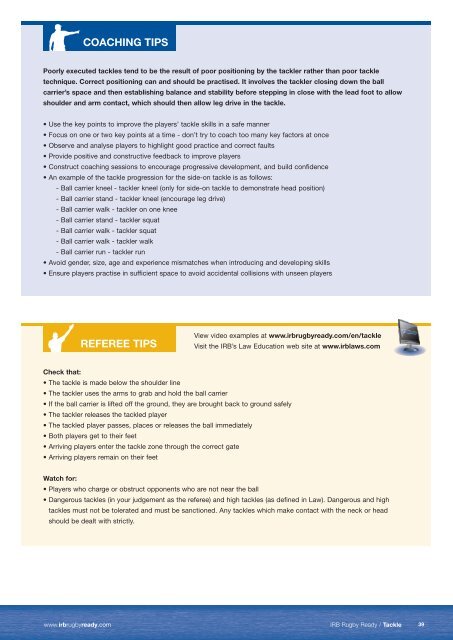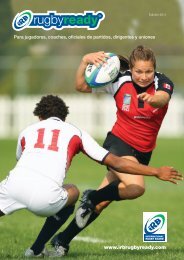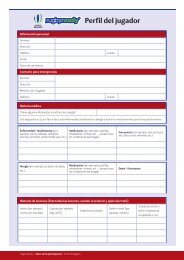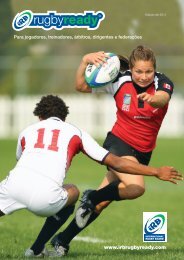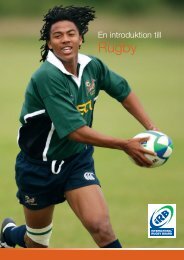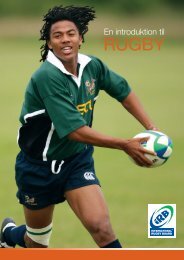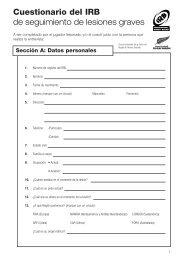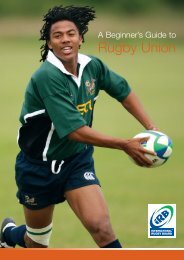IRB Beginner's Guide to Rugby - IRB Rugby Ready
IRB Beginner's Guide to Rugby - IRB Rugby Ready
IRB Beginner's Guide to Rugby - IRB Rugby Ready
You also want an ePaper? Increase the reach of your titles
YUMPU automatically turns print PDFs into web optimized ePapers that Google loves.
COACHING TIPS<br />
Poorly executed tackles tend <strong>to</strong> be the result of poor positioning by the tackler rather than poor tackle<br />
technique. Correct positioning can and should be practised. It involves the tackler closing down the ball<br />
carrier’s space and then establishing balance and stability before stepping in close with the lead foot <strong>to</strong> allow<br />
shoulder and arm contact, which should then allow leg drive in the tackle.<br />
• Use the key points <strong>to</strong> improve the players’ tackle skills in a safe manner<br />
• Focus on one or two key points at a time - don’t try <strong>to</strong> coach <strong>to</strong>o many key fac<strong>to</strong>rs at once<br />
• Observe and analyse players <strong>to</strong> highlight good practice and correct faults<br />
• Provide positive and constructive feedback <strong>to</strong> improve players<br />
• Construct coaching sessions <strong>to</strong> encourage progressive development, and build confidence<br />
• An example of the tackle progression for the side-on tackle is as follows:<br />
- Ball carrier kneel - tackler kneel (only for side-on tackle <strong>to</strong> demonstrate head position)<br />
- Ball carrier stand - tackler kneel (encourage leg drive)<br />
- Ball carrier walk - tackler on one knee<br />
- Ball carrier stand - tackler squat<br />
- Ball carrier walk - tackler squat<br />
- Ball carrier walk - tackler walk<br />
- Ball carrier run - tackler run<br />
• Avoid gender, size, age and experience mismatches when introducing and developing skills<br />
• Ensure players practise in sufficient space <strong>to</strong> avoid accidental collisions with unseen players<br />
REFEREE TIPS<br />
View video examples at www.irbrugbyready.com/en/tackle<br />
Visit the <strong>IRB</strong>’s Law Education web site at www.irblaws.com<br />
Check that:<br />
• The tackle is made below the shoulder line<br />
• The tackler uses the arms <strong>to</strong> grab and hold the ball carrier<br />
• If the ball carrier is lifted off the ground, they are brought back <strong>to</strong> ground safely<br />
• The tackler releases the tackled player<br />
• The tackled player passes, places or releases the ball immediately<br />
• Both players get <strong>to</strong> their feet<br />
• Arriving players enter the tackle zone through the correct gate<br />
• Arriving players remain on their feet<br />
Watch for:<br />
• Players who charge or obstruct opponents who are not near the ball<br />
• Dangerous tackles (in your judgement as the referee) and high tackles (as defined in Law). Dangerous and high<br />
tackles must not be <strong>to</strong>lerated and must be sanctioned. Any tackles which make contact with the neck or head<br />
should be dealt with strictly.<br />
www.irbrugbyready.com<br />
<strong>IRB</strong> <strong>Rugby</strong> <strong>Ready</strong> / Tackle<br />
39


